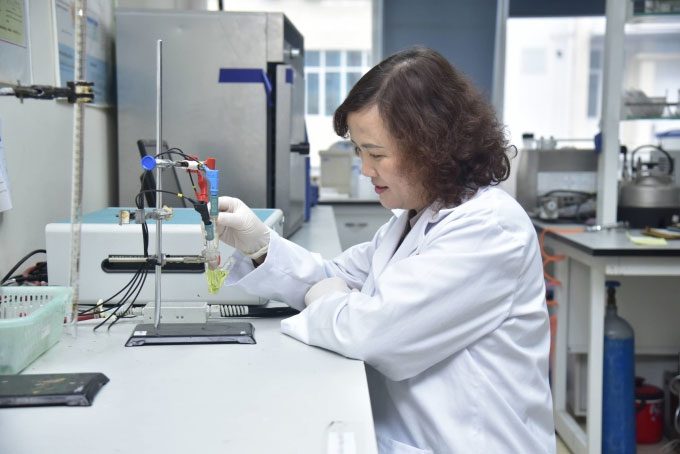Professor Dr. Dinh Thi Mai Thanh and her team successfully developed a new drug-carrying material that can destroy 75% of bladder cancer cells.
Professor Mai Thanh and her colleagues at the University of Science and Technology of Hanoi (USTH), Vietnam Academy of Science and Technology, created a new composite material made from superparamagnetic iron oxide nanoparticles (SPIONs) and hydroxyapatite (HAp). Thanks to its ability to generate heat under magnetic fields and facilitate drug delivery, this material can effectively kill bladder cancer cells when loaded with the chemotherapy drug 5-FU.
The material, termed “superparamagnetic hybrid,” consists of a core of SPIONs surrounded by HAp with drug-loaded porous structures created through adsorption. It is used as a substrate to immobilize various anticancer drugs for localized release. When combined with copper (Cu) and 5-FU and introduced into the body, the SPIONs generate heat under an external magnetic field, releasing the therapeutic drug and destroying cancer cells.
Professor Dinh Thi Mai Thanh, 50 years old, stated that the success of this research lies in demonstrating the synergistic effect of magnetic hyperthermia techniques combined with anticancer agents in destroying cancer cells. “The combination of SPIONs with anticancer agents provides a greater synergistic effect on cancer cells compared to traditional chemotherapy,” Professor Thanh told reporters. This material can kill up to 75% of cancer cells.

Professor Dr. Dinh Thi Mai Thanh conducting research in the laboratory. (Photo: VAST).
The superparamagnetic hybrid material represents a significant milestone in Professor Dinh Thi Mai Thanh’s ongoing research journey to discover new materials for medical applications. Since 2010, her team has pursued the development of materials based on traditional biomaterials, benefiting from the biocompatibility of HAp, which is used in calcium supplement powders, HAp films coated on biomedical alloys for screws and plates, and composites with polylactic acid (PLA) for biodegradable implants. In 2020, the idea of creating a composite by combining HAp and superparamagnetic nano-oxides (SPIONs) emerged during research discussions with Polish partners.
Initially, the research team synthesized superparamagnetic nanoparticles, then coated HAp onto SPIONs and subsequently adsorbed the anticancer drugs. One limitation of superparamagnetic iron oxide nanoparticles is their tendency to aggregate and difficulty in entering the body; however, when combined with HAp to form a composite, they demonstrate improved drug delivery capabilities.
The research team conducted cell experiments using colorimetric assays to assess drug release capabilities and to monitor cell viability and death rates. Results indicated that the cancer cell kill rate reached 75% after 2,000 seconds under the influence of an external magnetic field at a temperature of 45 degrees Celsius. The SPIONs have been applied in treatments even for chemotherapy-resistant and radioresistant tumor cells.
The research team is currently collaborating with Poland to conduct in-depth studies on animal models and test this mechanism on other cancer treatment drugs, such as those for ovarian and liver cancer.
According to Professor Thanh, cancer research in Vietnam still faces many challenges. These include the very stringent processes involved in research, from animal trials to clinical studies and finally to human applications, which must pass through ethical review boards before new products can be utilized. “This poses difficulties for scientists pursuing biomedical applications, not to mention that costs in later stages can be quite high, especially for animal and human testing,” she noted.

Images of the newly synthesized material in solid form (image a), suspension form (image b), scanning electron microscope (SEM) image of the material (image c), and transmission electron microscope (TEM) image of the material (image d). (Photo: Research Team).
With expertise in chemistry, Professor Mai Thanh has dedicated many years to researching new materials. Previously, her research focused on creating lead dioxide electrodes based on titanium metal for use as an anode in lead-acid batteries for motorcycles and cars. Since 2010, she has concentrated on developing HAp materials for biomedical applications, including powders, films, and composites. Additionally, HAp materials in powder form are also used in environmental treatments, such as wastewater from landfills containing electronic waste, and for recovering metal ions, especially rare earth metals.
Reflecting on her research journey, she stated that her professional orientations have developed through research and collaboration with partners, while also addressing Vietnam’s pressing issues. “New technologies often lack a clear direction; we primarily persist in pursuing research avenues and collaborate with groups for mutual development,” Professor Thanh said, emphasizing that the biomedical field requires interdisciplinary participation from materials science, chemistry, and biotechnology. However, the transition of research products from basic to applied stages can sometimes take a lifetime. Therefore, she believes it is essential to first advance basic research to set the orientation, and once well-developed, it will serve as a foundation for applications.



















































